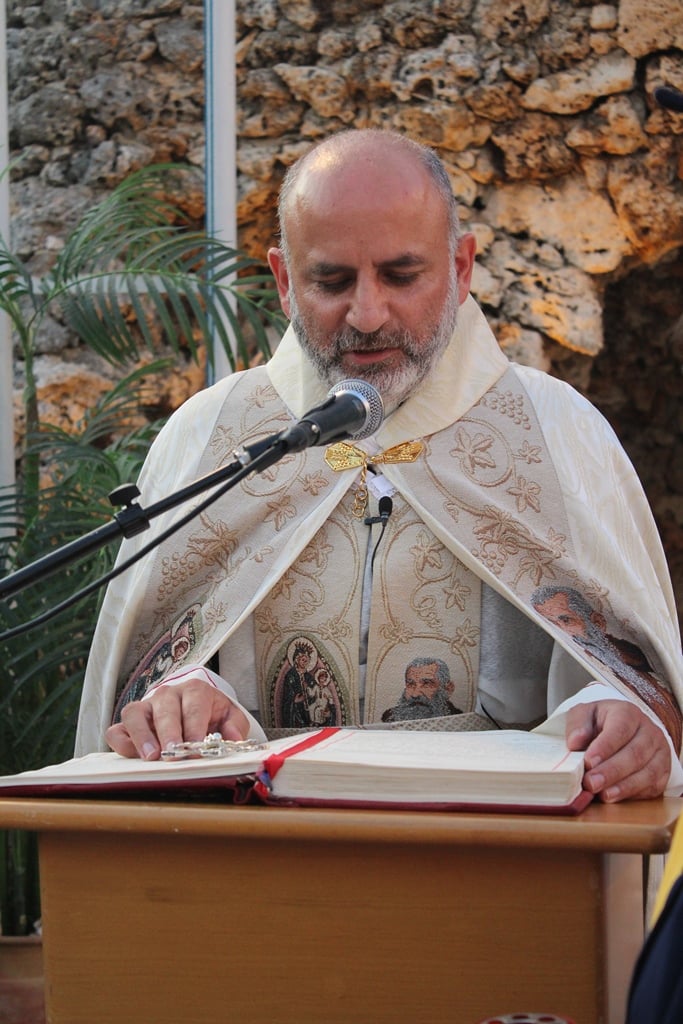الحلم الشيعي الإيراني المروع
يجب تدمير الجمهورية الإسلامية، سواء طورت أسلحة نووية أم لا
لورانس فرانكلين/جويش نيوز سينديكيت/14 أغسطس/آب 2024
(ترجمة من الإنكليزية إلى العربية بواسطة موقع غوغل)
Iran’s apocalyptic Shi’ite dream
Hence, now or later, the Islamic Republic must be destroyed, whether they develop nuclear weapons or not.
Lawrence Frankline/Jewish News Syndicate/August 14/2024
To crush Sunni Islam, Iran must “persuade” the U.S. to jettison its view that Middle East stability is a vital American national interest.
It might be news to the United States and Israel that despite the Satanic appellations assigned to them by Iran’s regime—“Big and Little Satan” respectively—neither figure in the Islamic Republic’s final objective, which defines Shi’ite Islam. Iran’s theocratic worldview is shaped by the Shi’ite belief that Muhammad’s will was betrayed by the Sunni Caliphs who immediately succeeded the prophet. The true believers in the Shi’ite hierarchy assert that the Sunni hijacking of Islam will end with the return of the Imam Zaman (the Twelfth Imam), ushering in the end times.
For certain, the Islamic Republic employs the “Zionist Entity” as a foil to obscure its apostate image among Sunnis. Iran’s militancy also diminishes Saudi Arabia’s traditional primacy as guardian of Sunni Islam’s global interests. Iranian efforts to recruit both Shi’ite and Sunni Muslims to join the anti-Zionist “resistance” have succeeded in capturing the passion of even some Sunni extremist groups, like Hamas.
Although Iran’s revolution is a modern occurrence (1979), the essence of its theological ideology is rooted in the first decades of Islamic history. The Sunni-Shi’ite divide is traceable to the refusal by Damascus-based Umayyad dynastic Islamic notables to recognize the claim of Ali, the son-in-law and nephew of Muhammad, as the prophet’s legitimate successor as leader of Islam. Though Ali ultimately was named the Fourth Caliph, Sunni leaders disinherited his sons, killing his youngest, Hussain, and many of his followers at the Battle of Karbala, Iraq in 680 CE.
Following the defeat of their Shi’ite rivals, Sunni Muslims dominated the “Islamic world” in both power and population for centuries, except for a few periods of regional Shi’ite ascendancies. All that changed with the U.S.-led destruction of the Sunni dictatorship of Saddam Hussein. The demise of Saddam liberated Iraq’s Shi’ite majority, many of whom felt an affinity for Shi’ite Iran across the border. It is these Shi’ites who make up the several terrorist gangs in Iraq who do the bidding of Iran’s extremist regime.
Iran’s theocratic ideologues also share old-school ties with Iraq’s leading clerics, many of whom were trained in the same Shi’ite seminaries in Najaf (Iraq) and Qom (Iran). The overriding goal of Iran’s Shi’ite clerics is finally to replace Sunni dominance; first in the Middle East and eventually throughout the Islamic world. Iranian muscle in the Persian Gulf has now outclassed the Arabian Peninsula’s monarchial Sunni states in raw power. While these peninsular kingdoms remain wealthy, their thrones rest on sand. For the foreseeable future, they will all require protective guarantees from the calvaries of heathen states like America, Israel or China. Iran has appealed to Shi’ite minorities around the world, including in South Asia, West Africa and Mainland as well as Archipelago Southeast Asia. Iran has embraced Syria’s Alawite rulers as legitimate fellow Shi’ites. It has recruited Shi’ite soldiers from Afghanistan and Pakistan to join the ranks of the Lebanese Shi’ite terror group Hezbollah and Yemen’s ethnic Houthi Shi’ites who serve in the pro-Iranian international brigades fighting Tehran’s wars in the Mideast.
To deal the killing blow to Sunni political and religious Islam in the Gulf, Iran must “persuade” the U.S. to jettison its view that Middle East stability is a vital American national interest. Such a calculation by U.S. national security experts would, by definition, force Washington to reevaluate America’s longstanding commitment to Israel’s defense.
Iran’s efforts to create anti-Israel sentiment among segments of the U.S. population are precisely orchestrated to attrit traditional popular support for Israel among American citizens. The mobilization of Muslim-American sentiment for the “Palestinian cause,” together with idealistic and naïve support among some college students, has already influenced the 2024 U.S. presidential election to a greater degree than ever envisioned by Russia or China. Vice President Kamala Harris’s decision not to select the popular Jewish-American Democratic Governor of Pennsylvania Josh Shapiro as her running mate buttresses the accusation that she has bowed to the anti-Israel faction of her party, which includes open antisemites in its ranks.
Iran’s future strategy to undermine the American presence in the Middle East may include several confrontational tactics: Tehran could seek to enflame the Shi’ite-majority population of Saudi Arabia’s Eastern Province. This region is the site of much of the kingdom’s oil wealth and has traditionally been a center of deep opposition to the ruling al-Saud dynasty, the global standard bearer of Sunni Islam.
Another disruptive option is already in play: Iran’s propagandists are presently stoking existing anti-Israeli animosities among Palestinian Arabs living in Judea and Samaria. Iran hopes these Palestinians will violently resist Israel’s administrative control to create another front on Israel’s borders.
Tehran’s radicalization of this population may also be used to attempt to topple the already teetering Hashemite dynasty in Jordan. Indeed, King Abdullah II might be the last King of Jordan, as his country’s Palestinian Arab population continues to grow. The overthrow of the Hashemites would remove a pro-Western ally that Iran could use as another tentacle in its anti-Israel strategy.
Furthermore, Iran has a subterranean network of cooperative elements in the Kingdom of Bahrain. This Sunni-ruled island state hosts the headquarters of the U.S. Navy’s Fifth Fleet and is a pro-Western ally in the Mideast. The dissolution of al-Khalifa dynastic rule in Bahrain would probably lead to the ouster of the Fifth Fleet, complicating the West’s ability to police Iranian aggression in the Persian Gulf.
Bahrain is vulnerable to the Islamic Republic’s malevolent designs because its Sunni dynasty rules over a restive, much larger Shi’ite population. The al-Khalifa Dynasty is unpopular but maintains control through a predominantly South Asian thuggish paramilitary of mercenaries. As an emergency security backup, a 15-mile bridge and causeway complex, built, in part, for a quick suppressive response, connects Bahrain to Saudi Arabia.
The U.S. and Israel must never underestimate Iran’s willingness to act on its ideologically inspired, apocalyptic dream that the Shi’ite narrative will be the universally accepted true legacy of Islam. The diminution of democratic power in the region will only lead to bolder moves by Iran’s clerics and their military class of zealots in the Islamic Revolutionary Guard Corps (IRGC). Hence, now or later, the Islamic Republic must be destroyed, whether they develop nuclear weapons or not.
https://www.jns.org/irans-apocalyptic-shiite-dream/
***Lawrence Franklin
Col. Lawrence Franklin was the USAF Reserve Military Attaché to the U.S. Embassy in Israel and the U.S. Defense Secretary’s Farsi-Speaking Iran Officer and Islamic Terrorism specialist. He holds a PhD is in Asian Studies.
الحلم الشيعي الإيراني المروع
يجب تدمير الجمهورية الإسلامية، سواء طورت أسلحة نووية أم لا
لورانس فرانكلين/جويش نيوز سينديكيت/14 أغسطس/آب 2024
(ترجمة من الإنكليزية إلى العربية بواسطة موقع غوغل)
لسحق الإسلام السُنّي، يجب على إيران “إقناع” الولايات المتحدة بالتخلي عن وجهة نظرها القائلة بأن استقرار الشرق الأوسط يشكل مصلحة وطنية أميركية حيوية.
قد يكون من الأخبار الجديدة بالنسبة للولايات المتحدة وإسرائيل أنه على الرغم من التسميات الشيطانية التي أطلقها عليهما النظام الإيراني – “الشيطان الأكبر والشيطان الأصغر” على التوالي – فإن أياً منهما لا يشكل هدفاً نهائياً للجمهورية الإسلامية، والذي يحدد الإسلام الشيعي. إن النظرة العالمية الثيوقراطية لإيران تتشكل من خلال الاعتقاد الشيعي بأن إرادة محمد خانها الخلفاء السُنّة الذين خلفوا النبي على الفور. ويؤكد المؤمنون الحقيقيون بالتسلسل الهرمي الشيعي أن اختطاف السنة للإسلام سينتهي بعودة الإمام الزمان (الإمام الثاني عشر)، مما يبشر بنهاية الزمان.
لا شك أن الجمهورية الإسلامية تستخدم “الكيان الصهيوني” كوسيلة لإخفاء صورتها المرتدة بين أهل السنة. كما تعمل نزعة إيران النضالية على تقليص التفوق التقليدي للمملكة العربية السعودية باعتبارها حارسة للمصالح العالمية للإسلام السني. وقد نجحت الجهود الإيرانية الرامية إلى تجنيد المسلمين الشيعة والسُنّة على حد سواء للانضمام إلى “المقاومة” المناهضة للصهيونية في جذب حماسة بعض الجماعات السُنّية المتطرفة، مثل حماس.
ورغم أن الثورة الإيرانية تشكل حدثاً حديثاً (1979)، فإن جوهر إيديولوجيتها اللاهوتية متجذر في العقود الأولى من التاريخ الإسلامي. ويمكن إرجاع الانقسام السني الشيعي إلى رفض كبار رجال الدين الإسلامي الأمويين في دمشق الاعتراف بمطالبة علي، صهر النبي محمد وابن أخيه، بأنه الخليفة الشرعي للنبي كزعيم للإسلام. ورغم أن علياً قد سمي في النهاية الخليفة الرابع، فقد حرم زعماء السنة أبنائه من الميراث، فقتلوا أصغرهم حسين والعديد من أتباعه في معركة كربلاء بالعراق في عام 680 ميلادية.
وبعد هزيمة منافسيهم الشيعة، هيمن المسلمون السنة على “العالم الإسلامي” من حيث القوة والسكان لعدة قرون، باستثناء فترات قليلة من الهيمنة الشيعية الإقليمية. ولكن كل هذا تغير مع تدمير الدكتاتورية السنية لصدام حسين بقيادة الولايات المتحدة. فقد أدى سقوط صدام إلى تحرير الأغلبية الشيعية في العراق، حيث شعر العديد منهم بالتقارب مع إيران الشيعية عبر الحدود. وهؤلاء الشيعة هم الذين يشكلون العصابات الإرهابية العديدة في العراق التي تنفذ أوامر النظام المتطرف في إيران.
كما يشترك أصحاب الأيديولوجيات الدينية في إيران في روابط قديمة مع كبار رجال الدين في العراق، الذين تدرب العديد منهم في نفس المعاهد الدينية الشيعية في النجف (العراق) وقم (إيران). إن الهدف الرئيسي لرجال الدين الشيعة في إيران هو في النهاية استبدال الهيمنة السنية؛ أولاً في الشرق الأوسط وفي نهاية المطاف في مختلف أنحاء العالم الإسلامي. لقد تفوقت القوة الإيرانية في الخليج الفارسي الآن على الدول السنية الملكية في شبه الجزيرة العربية من حيث القوة الخام. وفي حين تظل هذه الممالك في شبه الجزيرة غنية، فإن عروشها تستقر على الرمال. وفي المستقبل المنظور، سوف تحتاج جميعها إلى ضمانات حماية من جيوش الدول الوثنية مثل أميركا أو إسرائيل أو الصين. وقد ناشدت إيران الأقليات الشيعية في جميع أنحاء العالم، بما في ذلك في جنوب آسيا وغرب أفريقيا والبر الرئيسي وكذلك أرخبيل جنوب شرق آسيا. كما تبنت إيران حكام سوريا العلويين باعتبارهم شيعة شرعيين. كما جندت جنوداً شيعة من أفغانستان وباكستان للانضمام إلى صفوف جماعة حزب الله الإرهابية الشيعية اللبنانية والشيعة الحوثيين في اليمن الذين يخدمون في الألوية الدولية الموالية لإيران والتي تقاتل حروب طهران في الشرق الأوسط. ولكي تتمكن إيران من توجيه الضربة القاضية للإسلام السياسي والديني السُنّي في الخليج، فلابد وأن “تقنع” الولايات المتحدة بالتخلي عن وجهة نظرها القائلة بأن استقرار الشرق الأوسط يشكل مصلحة وطنية أميركية حيوية. ومن المؤكد أن مثل هذه الحسابات التي يتوصل إليها خبراء الأمن القومي الأميركيين من شأنها أن تجبر واشنطن، بحكم التعريف، على إعادة تقييم التزام أميركا الطويل الأمد بالدفاع عن إسرائيل.
إن جهود إيران الرامية إلى خلق مشاعر معادية لإسرائيل بين شرائح من سكان الولايات المتحدة مُنَظَّمة بدقة لاستنزاف الدعم الشعبي التقليدي لإسرائيل بين المواطنين الأميركيين. إن حشد المشاعر الإسلامية الأميركية من أجل “القضية الفلسطينية”، إلى جانب الدعم المثالي والساذج بين بعض طلاب الجامعات، قد أثر بالفعل على الانتخابات الرئاسية الأميركية لعام 2024 بدرجة أكبر مما تصورته روسيا أو الصين على الإطلاق. إن قرار نائبة الرئيس كامالا هاريس بعدم اختيار حاكم ولاية بنسلفانيا الديمقراطي اليهودي الأميركي الشعبي جوش شابيرو كمرشح لمنصب نائب الرئيس يعزز الاتهام بأنها خضعت للفصيل المناهض لإسرائيل في حزبها، والذي يضم معادين للسامية بشكل علني في صفوفه.
قد تتضمن استراتيجية إيران المستقبلية لتقويض الوجود الأميركي في الشرق الأوسط عدة تكتيكات مواجهة: فقد تسعى طهران إلى تأجيج السكان الشيعة الأغلبية في المنطقة الشرقية بالمملكة العربية السعودية. إن هذه المنطقة هي موقع معظم ثروة المملكة النفطية، وكانت تقليدياً مركزاً للمعارضة العميقة لسلالة آل سعود الحاكمة، حاملة لواء الإسلام السني العالمي.
وهناك خيار تخريبي آخر قيد اللعب بالفعل: إذ يعمل دعاة إيران حالياً على تأجيج العداوات القائمة بين العرب الفلسطينيين الذين يعيشون في الضفة الغربية. وتأمل إيران أن يقاوم هؤلاء الفلسطينيون بعنف السيطرة الإدارية الإسرائيلية لإنشاء جبهة أخرى على حدود إسرائيل.
وقد تستخدم طهران أيضاً تطرف هذه الفئة من السكان لمحاولة الإطاحة بالسلالة الهاشمية المترنحة بالفعل في الأردن. والواقع أن الملك عبد الله الثاني قد يكون آخر ملوك الأردن، مع استمرار نمو السكان العرب الفلسطينيين في بلاده. ومن شأن الإطاحة بالهاشميين أن تزيل حليفاً موالياً للغرب قد تستخدمه إيران كذراع أخرى في استراتيجيتها المعادية لإسرائيل.
وعلاوة على ذلك، تمتلك إيران شبكة سرية من العناصر المتعاونة في مملكة البحرين. تستضيف هذه الدولة الجزيرة التي يحكمها السنة مقر الأسطول الخامس للبحرية الأميركية وهي حليفة موالية للغرب في الشرق الأوسط. ومن المرجح أن يؤدي حل حكم آل خليفة في البحرين إلى الإطاحة بالأسطول الخامس، مما يعقد قدرة الغرب على مراقبة العدوان الإيراني في الخليج الفارسي.
البحرين عُرضة للمخططات الخبيثة للجمهورية الإسلامية لأن سلالتها السنية تحكم سكاناً شيعيين مضطربين أكبر بكثير. إن سلالة آل خليفة غير شعبية ولكنها تحافظ على السيطرة من خلال شبه عسكري بلطجي من المرتزقة من جنوب آسيا. وكإجراء احتياطي أمني طارئ، يربط جسر بطول 15 ميلاً ومجمع طرق، تم بناؤه جزئياً للاستجابة السريعة للقمع، البحرين بالمملكة العربية السعودية.
لا ينبغي للولايات المتحدة وإسرائيل أن تقللا أبدًا من شأن استعداد إيران للعمل على تحقيق حلمها الإيديولوجي المروع بأن الرواية الشيعية ستكون الإرث الحقيقي للإسلام المقبول عالميًا. إن تقليص القوة الديمقراطية في المنطقة لن يؤدي إلا إلى تحركات أكثر جرأة من قبل رجال الدين الإيرانيين وطبقتهم العسكرية من المتعصبين في فيلق الحرس الثوري الإسلامي. وبالتالي، الآن أو لاحقًا، يجب تدمير الجمهورية الإسلامية، سواء طورت أسلحة نووية أم لا.
https://www.jns.org/irans-apocalyptic-shiite-dream/
***لورانس فرانكلين
كان العقيد لورانس فرانكلين الملحق العسكري الاحتياطي للقوات الجوية الأمريكية في السفارة الأمريكية في إسرائيل وضابط وزارة الدفاع الأمريكية الناطق باللغة الفارسية والمتخصص في الإرهاب الإسلامي. حاصل على درجة الدكتوراه في الدراسات الآسيوية.





















